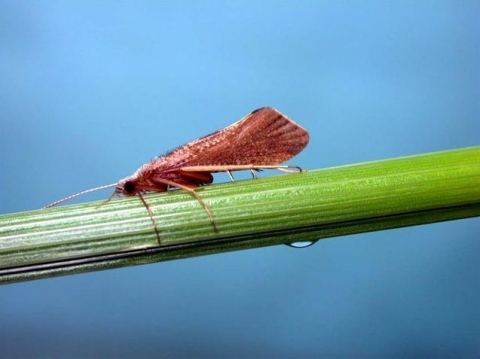Reintroduction and transportation of caddisfly larvae may depend on type, as some groups are perceived as being more robust, while others require higher maintenance.

Adult caddisfly Hydropsychidae
When predatory, free-living caddisflies (Trichoptera) such as Hydrobiosidae are confined to or are within close proximity to other invertebrates they exhibit aggressive behaviour, often devouring or maiming conspecifics and others. Since hydrobiosids also lack external gills, they are reliant on oxygen being absorbed through their body wall, and this lends itself to larvae requiring cool, well-oxygenated water.
Successful reintroduction of these larvae would require separation of individual larvae, maintaining cool conditions and perhaps aeration for longer trips. The larvae of spinning caddisflies such as Hydropsychidae and Polycentropodidae (and probably Philopotamidae and Ecnomidae) also exhibit aggressive behaviour to conspecifics and other invertebrates when confined, although they may be transported together, albeit in small numbers.
The larvae of non-predatory cased caddisflies such as Conoesucidae, Helicophidae, Calocidae, Oeconesidae and some Leptoceridae, to name a few, generally feed on biofilm, detritus, moss, leaves and sticks, and may therefore be transported in large numbers with relative ease. Predatory cased caddisfly larvae such as Philorheithridae, Kokiriidae and some Leptoceridae may need to be transported in low numbers.
Freshwater invertebrates exhibiting complete metamorphosis such as caddisflies have an additional life history stage, the pupa, which may be more suitable for re-introduction than larvae. This may be more practical for difficult to rear and transport organisms such as Hydrobiosis larva. Hydrobiosidae pupae can be collected from the field, and reared to maturity relatively easily. Hydrobiosid larvae that have just pupated are often visible through the pupal wall and can easily be identified to genus, and in some instances species. Mature pupae, identified by the dark wings of the adult visible through the pupae case, can be reintroduced in large numbers without difficulty, eliminating predation during transit. The larvae of many other caddisflies can however, be raised to pupae in the laboratory, and species identification can be assessed by examination of mature male pupae genitalia. Philorheithrus, Olinga and Helicopsyche demonstrate communal pupation and can be easy collected and transported.
The reintroduction of adult caddisflies can be a consideration for repopulating restored habitats, but a number of questions may need to be addressed. Life expectancy of adult caddisflies varies according to family. Longevity experiments have shown that Conoesucidae raised from pupae in the laboratory to be rather short lived (less than 8 days) whereas Hydrobiosidae and Hydropsychidae can range from 2–3 weeks.
caddisflies that do not build retreats or carry portable cases. an organism belonging to the same species as another organism. a coating or covering on the surface of a living or non-living substrate composed of organisms like bacteria, protozoa, algae, and invertebrate animals. dead or decaying organic material. a biological process which allows an animal to change from one form to another after birth or hatching, such as a caterpillar turning into a butterfly. This is a relatively fast process which involves cell growth and differentiation.
